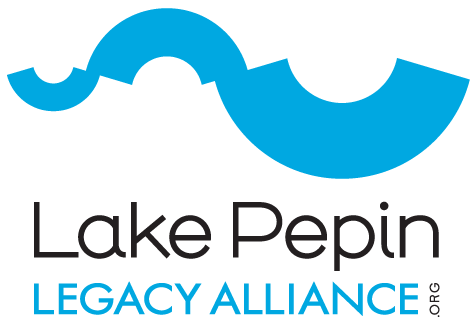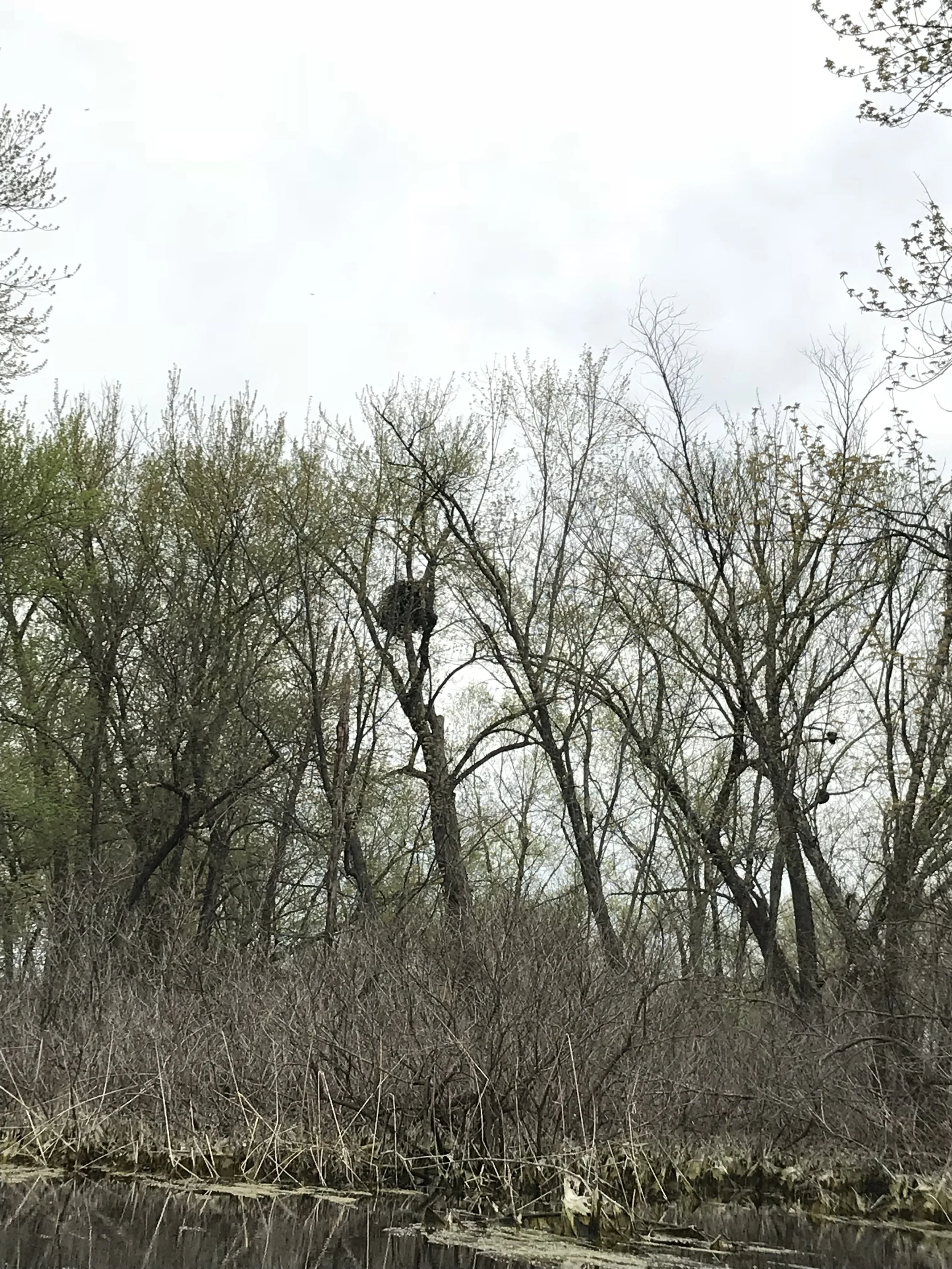By: Mac Becco, LPLA Communications Director
Annual spring floods turn floodplain forests around Lake Pepin into a dreamscape. Right off busy Highway 61, you can plop a boat in the water and, with a few strokes of the paddle, escape into a spectacular soiree hosted by the natural world. The wind plays percussion on the trees, birds sing to attract mates, and camouflaged (thereby unidentifiable) creatures make quiet splashes into the water. The sun glistens like a disco ball and fallen trees decorate the space with wooded arches reflected in the glasslike water. This ongoing eco-festival is Michael Anderson’s second home, main office, and personal sanctuary.
Michael is the purveyor of nature trips with Broken Paddle Guiding Company (BPG), an eco-tourism business he started in Wabasha, MN. Most BPG paddle trips weave through the forested floodplains just south of Lake Pepin where water is clear, vegetation is healthy, and wildlife is thriving. Periodically, however, BPG will lead trips through the backwaters of Upper Lake Pepin, which are beautiful, but less ecologically vibrant due to sediment accumulation and resuspension. The contrast between the two areas is striking, which is one reason Michael joined restoration efforts.
The Local Bottom Line
Michael Anderson is a wave of quiet surprises— thoughtful, easy going, and entirely unassuming. For starters, he came to Lake Pepin to become the proprietor and innkeeper of Turning Waters Bed & Breakfast. Just 26 years old, Michael and friends transformed the B&B into a fun destination for young adventure seekers. Instead of doilies, patrons enjoy a rustic, yet modern aesthetic with opportunities to take guided kayak trips. It is here where the Broken Paddle Guiding (BPG) was born.
As if it’s a common business model, Michael nonchalantly describes that he was simply, “trying to create a business around the outdoors through the bed and breakfast, which turned out to be kayaking.”
Meanwhile, Michael sought other ways to get involved with what he values most—the outdoors and local community. He became a certified Master Naturalist through the MN Department of Natural Resources, water quality monitor with the Minnesota Pollution Control Agency, and started working the pizza nights at A to Z Produce and Bakery.
In the process, he discovered that Lake Pepin wasn’t like other popular outdoor destinations. It was—and still is— full of diverse perspectives and backgrounds, which together create an opportunity to build unique community and make real change. Michael clearly cares about people as much as the environment. As he so beautifully explains,
“I don’t like being in a place where everybody has the same ideas. Instead of being another cog in the giant wheel of eco-tourism in a large community, I would rather be part of something smaller and create a vision that actually helps an area. Go to the place where a few people trying to do something and be a part of that. You have the ability to do more in those situations.”
Across all his endeavors, Michael’s bottom line is focused on people—building and sustaining local communities. After selling Turning Waters B&B to focus on kayak guiding with BPG, Michael also became co-owner of the Dancing Gnome Farm with his partner Lauren. And, it’s not a surprise that he also joined the LPLA Council of Champions, a local group of stakeholders that provide LPLA with guidance and feedback.
“Having the lake and river so prominent is the reason people come here and the reason people want to come here. Without it, [the community] would die off,” he says, “And to be honest, I’m not a [paying] member of many things. But I am for local efforts to do local things. That’s one reason I support [LPLA]. I don’t have a lot of money, but I would rather give my $25 or $50 to a local non-profit than a national one. It’s a local issue to me.”
The Hero’s Curse
Michael has gained unique insight into Lake Pepin because BPG kayaks both ends of the lake, which support noticeably different aquatic environments. BPG's experience highlights the hero’s curse of Lake Pepin as a huge filtration system for the Upper Mississippi River, which drains nearly half of the Minnesota landscape.
To the benefit of everything downstream, polluted water comes into Lake Pepin and relatively clean water goes out. The sacrifice, however, is that the pollutants accumulate and negatively impact local areas of the lake. Turbid, or cloudy water gradually becomes clearer downstream as sediment settles from the water column. The relatively clear water at the outlet of Lake Pepin is a major prerequisite to the vibrant wildlife that is found there.
As Michael explains, it also shapes human activity in the area, “There is a reason [BPG] is based in Wabasha. We do our tours here because everything about nature is more intense down here compared to the head of Lake Pepin. Aquatic vegetation, bald eagles, and other wildlife—there’s a lot more of everything down here.”
It’s no joke. LPLA kayaked with Michael through the forested floodplains near the outlet of Lake Pepin and it was an unbelievable experience. During our one-hour paddle, we saw Canadian Geese, American Widgeons, snapping turtles, downy woodpeckers, Prothonatary Warblers, tree swallows, a beaver dam, and numerous bald eagle nests. And that list is only what was picked up by the audio recorder.[1]
Michael is a great tour guide–not just because he gets excited when you spot something of interest–but also because of his local knowledge. He seemed to know where all the bald eagle nests were located and shares that,
“In one spot there are three nests all within 200 yards of each other. They can be that dense because there is little competition for food. The habitat supports so much food. It’s just wild!”
BPG kayak trips at the head of Lake Pepin are infrequent and characterized by a different nature experience. The beauty is undeniable, but the water is cloudy from suspended sediment. Without light penetration, there is also less aquatic vegetation and thereby wildlife than seen in lower Lake Pepin.
“You stick your paddle in the water and you can’t see a foot down,” says Michael.
Kayakers also get stuck while paddling the backwaters around Bay City, WI. Michael explains, “I’ve even had to drag people through Catherine’s Pass because the water can be as shallow as an inch. That’s something for a kayak!”
As Michael sees it, sediment should be a uniting force for all of Lake Pepin and the entire Mississippi River. Locally, it threatens ecological collapse, community isolation, and boat groundings. The impacts are getting worse and expanding downstream. Regionally, sediment is undermining Lake Pepin’s existence as a water filter. If the lake fills in with sediment, there won’t be anything protecting downstream areas from the same fate of those now impacted.
Practical Restoration
One million metric tons of sediment—enough to fill a city block to the height of the Foshay Tower in downtown Minneapolis—accumulates in Lake Pepin every year. As awareness of this fact grows, people have rightfully exclaimed that sediment reduction would be a more sustainable approach than restoration. Michael “subscribes to this feeling”, but also understands the challenging dynamics at play. As he sees it,
“It’s too hard to do something about [upstream land use] practices. And when you can’t fix the source of a problem very easily, you don’t just ignore it. If we let the flats around Bay City fill in, we would knock out any kind of human dimension we have. You couldn’t fish, kayak, or boat there. All that would be gone. It’s really crass, but restoration is like putting a band-aid on the problem. As I understand it, that’s why LPLA spearheaded restoration.”
Michael is right. Sediment reduction has proven to be an impractical solution for the last several decades [2] and local communities can no longer wait for improvements. Restoration might not be a silver bullet solution, but it does give Lake Pepin a fighting chance. As Michael reminds us, it might even make upstream sediment reductions more feasible in the future.
“Hopefully, [restoration] will draw attention to the upstream problem and [land use practices]…draw attention to what is making us put the band-aid on. For that reason alone, I think it’s worth it,” he says.
It’s true. Sometimes the best way to reduce upstream pollution is for the people impacted downstream to make some noise. Many will remember how another grassroots organization from Lake Pepin, Citizens for a Clean Mississippi River, mobilized over 2,000 members to successfully win lawsuits that reduced pollution from upstream wastewater facilities in the 1980’s. We enjoy the benefits of those efforts every day.
Restoration could be this generation’s rallying cry to reduce sediment from upstream fields, ravines, and streambanks.
As a restoration leader himself, Michael prioritizes Lake Pepin’s health above any potential business benefits. Like other local kayakers, BPG uses Catherine Pass to access the Bay City flats from the main channel. If that cut was plugged during restoration, it would be extremely inconvenient for their tours. Regardless, Michael supports closing it off if it will improve water quality and be better for the area overall.[3]
Michael’s practical perspective and ability to see multiple sides of an issue make him a vital addition to the LPLA Council of Champions. He helps remind all of us that protecting Lake Pepin is about more than any one person or interest. It’s about a shared identity and community—one united community all around Lake Pepin. Thank you, Michael!
[1] When asked where he wanted to be interviewed, Michael suggested on kayaks while exploring the forested floodplains. Michael guided a BPG “Raptor Tour” and answered some questions with an audio recorder in his PFD. Fortunately, he didn’t flip the kayak!
[2] The Minnesota Pollution Control Agency has determined that the Minnesota River, the biggest sediment contributor to Lake Pepin, needs to reduce sediment loading by 50% to achieve sustainable levels for Lake Pepin. Unfortunately, after 6 years of efforts (2010-2016), the Minnesota River experienced a sediment reduction of less than 1%.
[3] Preliminary assessment of sediment flow at the head of Lake Pepin suggest that Catherine’s Pass allows a large amount of sediment to enter the Bay City flats. The WI DNR predicts that achieving restoration goals will be easier if the pass is plugged. Meanwhile, the public has expressed concerns about this location's value as a fish spawning area, favorite fishing hole, and shortcut between the main channel and Bay City. More info here.





